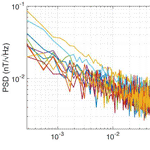Research article
| Highlight paper
|

28 Mar 2018
Research article |
Highlight paper |

|
28 Mar 2018

Investigation of a low-cost magneto-inductive magnetometer for space science applications
Leonardo H. Regoli, Mark B. Moldwin, Matthew Pellioni, Bret Bronner, Kelsey Hite, Arie Sheinker, and Brandon M. Ponder
A new sensor for measuring low-amplitude magnetic fields that is ideal for small spacecraft is presented. The novel measurement principle enables the fabrication of a low-cost sensor with low power consumption and with measuring capabilities that are comparable to recent developments for CubeSat applications. The current magnetometer, a software-modified version of a commercial sensor, is capable of detecting fields with amplitudes as low as 8.7 nT at 40 Hz and 2.7 nT at 1 Hz, with a noise floor of 4 pT∕Hz at 1 Hz. The sensor has a linear response to less than 3 % over a range of ±100 000 nT. All of these features make the magneto-inductive principle a promising technology for the development of magnetic sensors for both space-borne and ground-based applications to study geomagnetic activity.
Received: 08 Nov 2017 – Discussion started: 04 Dec 2017 – Revised: 26 Feb 2018 – Accepted: 27 Feb 2018 – Published: 28 Mar 2018





